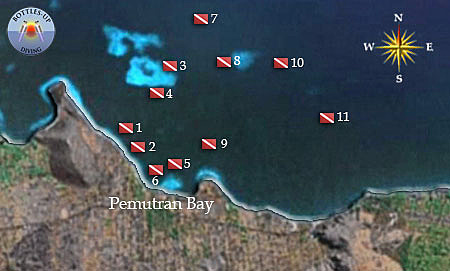Pemuteran
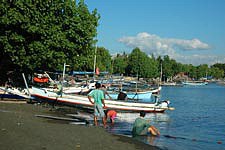
Pemuteran is a small fishing village situated on the north-west coast of Bali.
The village is near the Bali Barat National Park,
which can be explored by bike or by car.
Although Bali is mainly Hindu in this area there are also many Muslim people living peaceful side by side with the Hindu population.
The area is very arid in the dry season and experiences less rainfall during the wet season than the south of Bali which makes it a perfect escape for the months of December till February.
It also offer the right environment for growing grapes. On the way from Lovina to Pemuteran you will find a lot of vineyards where the grapes grow for the production of the Balinese wines.
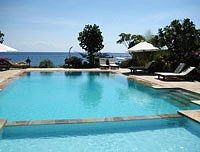
This is the first place in Bali where they started with reef protection, thanks to the dedication and efforts done by Chris Brown - owner of Reef Seen diver's resort.
When he arrived in the early nineties the reef was severely damaged due to dynamite and potassium cyanide fishing methods.
Another threat was formed by a plague of the Crown of thorns starfish (Acanthaster planci).
Chris Brown, together with the help of the local fishermen, removed over 70,000 Crown of thorns starfish from the reefs of Pemuteran, between the years of 1996 till 1998.
Just when people started to realize that the reef needed protection El Niño came along to damage the reef further.
Local resorts and dive operators started the reef project Karang Lestari where metal structures are placed in the sea.
These iron structures are wired which stimulates Coral growth on manmade metal structures using electricity.
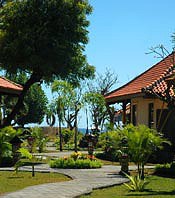
The beach - and beyond - in the bay has fine black volcanic sand.
The village itself is situated along the coastal road and offers very little entertainment during the nighttime which
is part of the attraction to visitors who love their peace and quietness.
Since 2014 this part of Bali is getting more devolved since many tourists like to escape the busy south of Bali.
This region offers the authentic Bali.
There are some up scaled resorts with everything on their premises, but now - 2016 - more places in the middle price range, with their own pool and a restaurant, are popping up.
For divers it is nice to have your dive facility with your hotel/resort and this we can arrange.
Dive conditions Pemuteran
Currents are mild or non-existent close to the shore and stronger the further you go out and the visibility
is generally good but can be less close to the shore.
The water temperature is almost always between 27°C - 29°C which makes it a good location for divers who are easily affected
by cold water temperatures.
Less rainfall during the wet season than the south of Bali which makes it suitable for diving during the months of December till February,
see the detailed weather graphs.
Pemuteran annual weather graphs




 © 2010-2015 World Weather and Climate Information
© 2010-2015 World Weather and Climate Information
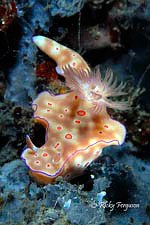
All the sites are just a short boat ride away - maximum 15 minutes - so there is the benefit of having your lunch back at the shore!
What is surprising is that there is so much to see in Pemuteran bay itself - this is real muck diving.
Just put on a tank and walk into the water and you can see things like Seahorse's, Octopus, weird Crabs and Frogfish,
all within a few metres from the shoreline.
We like to do shore dives at the jetty where you can find all kinds of juvenile species..., the site is not described here, but
easy to spot when you are on the beach!
Most of the dive sites in Pemuteran bay are excellent sites for night diving, but also for snorkeling.
The usual marine life consist of schooling Jacks, Snapper, Red-eye bass, Trevally, Batfish, Sweetlips, Angelfish, Damselfish and Fusiliers.
If you are lucky and/or the season is right there are the occasional Sharks, Barracudas, Tunas, Bumphead parrotfish, Turtles,
Whales (well... don't count too much on that), Dolphins and large Rays.
Shark numbers are decreasing at a shocking rate.... What all people, especially divers, should know about the shark population.
Shark population
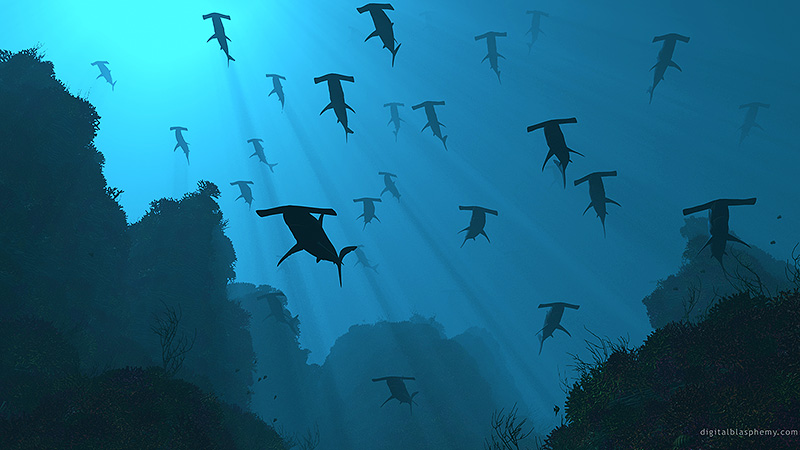
Most divers would love to see sharks, but should realize that there is a great slaughter amongst these apex predators happening every single day.
Indonesia ranks number 1 on the list of top 20 shark catchers.....
Diving in 1995 in the Bunaken national park we encountered sharks every dive. When we went back in 2008 we saw maybe 5 sharks on a total of 60+ dives!
When describing dive sites, we often mention that you might see sharks, but every year the chances are less..
An estimated 100 million sharks a year are killed, mostly for shark fin soup, says a shark researcher of the University of Windsor.
These are the shocking results done by the Institute for Environmental Research published in March 2013 in the journal Marine Policy.
The postdoctoral researcher, Steve Kessel, was part of this research team that came up with a more comprehensive estimate of the number of sharks being killed each year.
Due to the incomplete nature of the data for shark catches, that number could be as low as 63 million or as high as 273 million, but both the high and low end estimates are
considered outside of safe biological limits.
The study also found shark populations cannot reproduce fast enough to overcome that death rate.
There are about 400 species of sharks and 28% of them are threatened by extinction, Kessel said.
“One in every 15 sharks is taken every year”.
The Top 20 shark catchers in descending order are:
Indonesia, India, Spain, Taiwan, Argentina, Mexico, United States of America, Malaysia, Pakistan, Brazil, Japan, France, New Zealand,
Thailand, Portugal, Nigeria, Islamic Republic of Iran, Sri Lanka, Republic of Korea, Yemen.
Sources UNFAO, TRAFFIC 2013
Indonesia and India are responsible for over 20% of global catches between 2002 and 2011. Three EU Member States: Spain, France and Portugal, are among the top 20 shark catchers, responsible for 12% of global catches. Collectively, the 28 EU Member States are the largest shark catching entity of all.
Major hotels that continue to serve shark fin soup include:
Ritz Carlton-Hong Kong
Nikko hotels throughout Asia (headquartered in Japan)
Regal Hotels in Hong Kong
Prince Hotels and Resorts in Japan
InterContinental Group, a UK-based company
This list was comprised in conjunction with Wildlife risk.
Dive sites Pemuteran
Use the map to jump to the dive site :Temple Garden - [1]
Constructed as one of the three Bali Reef Foundation/Australian Aid funded projects, with Chris Brown from
Reef Seen Aquatics as main contributor together with some of the other local divecentres.
This eery location consists of a small temple complex starting a 30m and works its way back to the Temple Wall.
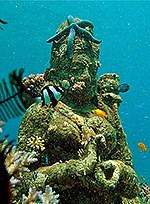
Statues of Buddha, Ganesha, Turtles are gathered behind an ornate Balinese gateway.
Behind the central statue is an interesting little bommie with Buddha heads covered in cleaning Shrimps.
Up the wall and in the crevices behind you can find Electric clamps, sparking away.
Then at 15m you come to an area with statue heads sitting in communion; quit a sight.
This is not a spectacular dive, but with the right
weather conditions it can be great site for photographers.
Temple Wall also known as the Maze - [2]
This small wall beneath Pura Bratan is close to shore which sometimes makes for poor visibility, but it's an interesting dive with
a good selection of Crustaceans.
Coral cover and Sponges proliferate along the far end where the wall sharply curves into the bay beyond.
The wall bottom ranges from 16 to 35m and crosses into the deep where a fascinating maze configuration heads out across the next bay.
This second deep dive offers some large Gorgonians and is for experienced divers only.
Canyon Wreck - [3]
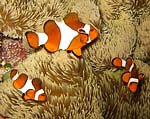
This is the second of the three Bali Reef Foundation/Australian Aid funded projects, with some of the local dive-centres:
Canyon Wreck a 30m long traditional motorsailer sits in an unusual valley. With its stern up against a wall which juts out at the open
end of the valley. She rests in 30+m of water.
Her bow point into the valley and swimming out over her portside brings you to a steep slope which continues into an amazing
area of hard Coral cover.
Kuburan Kapal - Wrecks, bommie & Walls - [4]
The last of the three Bali Reef Foundation/Australian Aid funded projects with some of the local dive-centres.
Marked by a floating pontoon Kuburan Kapal consists of nine wrecks ranging from a 30m traditional motorsailer to a canoe.
The largest rests at the base of a sandy slope and has become home to many small fish who like to hide within.
At the top is the 'Biowreck', part of an ongoing Coral restoration project which utilises electricity to stimulate Coral growth.
Huge - supposed to be the largest in Bali - Coral bommie, consisting of a single colony stands next to the 'Biowreck'.
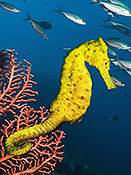
Kebun Chris - Chris's Garden - [5]
Named after Chris Brown, a local dive-centre owner, eco warrior and dive pioneer in this area.
This site is located in front of his dive centre and Turtle hatchery.
This shallow dive site has a depth of 10-12m and has a great mixture of hard and soft Corals, with a lot of colour.
Lots of little stuff, Pipefish in different varieties, Seamoths, Seahorse and Mandarin fish can all be found here and with
the site being so shallow you have lots of time to look.
Kebun Batu - The Rock Garden & Karang Lestari (Biorock) - [6]
Kebun Batu or Rock Garden is in front of the Karang Lestari Coral project, just off the beach in front of the local hotels and is
clearly marked with a very prominent white buoy.
The Rock itself rises from a sandy bottom no deeper than 18m as a pinnacle or Coral with a flat top at the 4m mark.
The base of the rock on the shore side rises in a small Coral mound to 8m. The surrounding sand slopes gently up to the beach.
The rock itself is an interesting dive during the day offering a lot of critters and small fish, but it really comes alive during
the night with small Lobster, Shrimps and Crabs.
The metal frames from the 'Bio reef project' are a nursing ground for fish, which have come to regard them as homes.
Frogfish can often be found on Sponge covering areas of the structures.
Close Encounters - east slope and west slope) - [7]
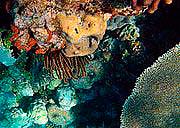
This site has steep sloping sides coming up to a flat top, with depths ranging from 12m at the far end to 3 - 4m in the shallow.
The slopes themselves start to level off to a gentle sandy bottom at 25 - 30m.
The Coral cover along the slopes is a good mix of hard and soft covering; the east side is particularly good with many little
nooks 'n' crannies, healthy Sponges, providing many hiding places for a variety of interesting marine life.
The top also has a good variety of Corals, Sponges, many small fish and is often home to baby Sharks who like to hide under large
table Corals.
Gede's Reef - [8]
You drop into the water and will encounter the reef which rises up from a depth of 40 - 50m. The shallowest point is at 13m, this
reef is full of marine life and dense Coral formations.
This pristine little reef makes for a fun blue water rush, with a large area of excellent Coral covering which is surprisingly full
of critters.
Many interesting and unusual Nudibranchs have been seen here and a large two metres high bright yellow Gorgonian at 24m.
Deep Reef - [9]
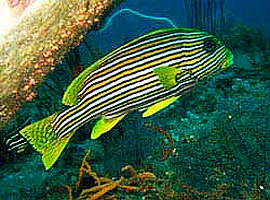
A small plateau rising up from 30+m with steep sides all round and a mostly flat top at 10m.
A nice little dive, though sometimes visibility can be a little lower than the norm due to it being closer to shore.
Napoleon Reef - Zoe Wreck - [10]
This site is a flat topped gently sloping reef, with a small wall towards the South side and a depth range the same
as Close Encounters.
The soft Coral garden towards the West is particularly pretty, offering a nice range of Gorgonians heading off into
the blue. The deep end of this site offers the usual and unusual fish from Close Encounters and in addition Rays and Cuttlefish are a
regular sighting.
This is also the site of a small wreck, the Zoe, an ex-dive boat scuttled back in 2004. Beyond the wreck lies another interesting little
deeper reef, nicknamed 'Beyond' Napoleon, with an interesting field of short Staghorn corals and Sponges.
Pulaki Reef - [11]
Situated in front of the temple baring the same name, the local dive operators are still exploring this site.
Until now they found a great wall, but the top of the reef is less interesting.
Bali's dive locations

